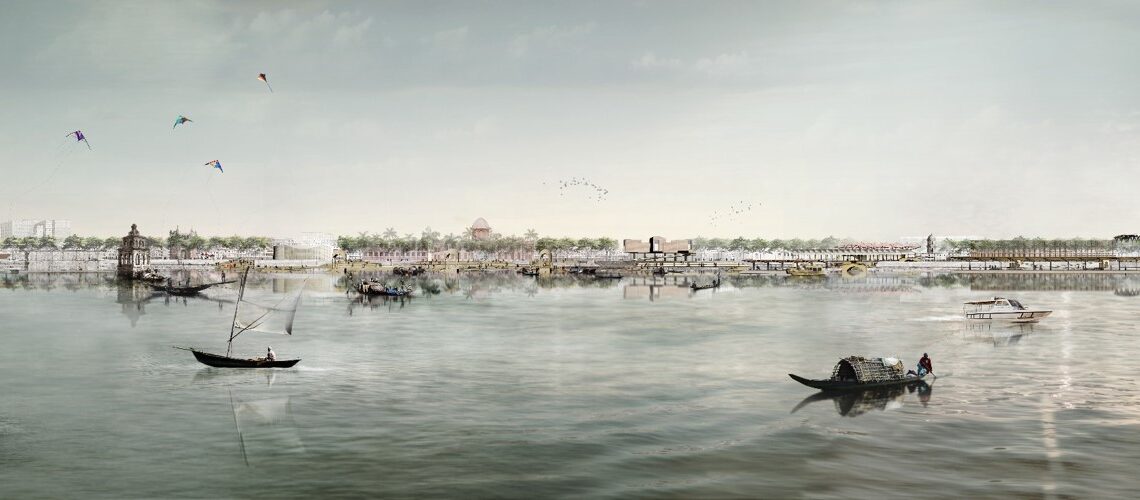In a slow gestating process, Bangladesh’s contemporary architecture has arrived at a global stage in a robust and formidable way. If 1952, and the Art College and Dhaka University Library mark the starting point of a modern architecture culture, it took a while for the new arrival.


Since the publication of the two iconic projects by Muzharul Islam in a special issue of “Commonwealth Architecture” in the prestigious Architectural Review in 1960, that was edited by Otto Koenigsberger, and sporadic mention of Islam’s work in later publications, the international attention of architecture in Bangladesh has been few. Far fewer were a theoretical narrative that anchored the production in the broader social and cultural milieu.
Although Muzharul Islam was part of an important exhibition in the USA in 1997 – “An Architecture of Independence: The Making of Modern South Asia,” that also included the works of Achyut Kanvinde, Charles Correa and Balkrishna Doshi (that I co-curated) – no extensive studies, exhibitions and publications, whether in Bangladesh or elsewhere, plumbed the depth and scope of Muzharul Islam. For years, Louis Kahn and his masterful work of the Parliament Complex provided the sole attention of the international media and serious architectural scholarship. While many architects in Bangladesh by and large claimed the Kahn complex as their own, and sought inspiration from it, they continued to work to arrive at their own destinations.
It may have been a little late in happening but architecture culture in Bangladesh now exhibits a spiritedness that also aligns with a new national poise. The newer works also address the fresh challenges of the times beyond the usual visual and aesthetical impetuses that have kept most practices going.
Perceptive architectural critics have noted the new phenomenon as the “rising” architecture of Bangladesh. From the ongoing exhibition, “Bengal Stream-The Vibrant Architecture Scene of Bangladesh,” that is traveling cities in Europe, to installations at the Venice Biennale, and from fresh attention of international publications, including The Architectural Review and The New York Times, architects in Bangladesh are enjoying new appreciation and attention. This is also amplified by invitations to exhibit at major galleries, speak at forums, and teach at prominent universities around the world, and winning prestigious awards. The publication of Locations: Anthology of Architecture and Urbanism, from Bengal Institute, for a world forum is also a significant first.

Image source: Swiss Architecture Museum

Image source: Marina Tabassum
Young architects and students should note that architects in Bangladesh have arrived at the international stage with works that have depth and content, and stories to tell the rest of the world. More importantly, the works have a theoretical underpinning emerging from new but localised conditions.
The new challenges of architecture arise beyond the display of sculptural flamboyance that one notices in commercial buildings and apartment complexes in Dhaka. Random sculpturesque buildings, while demonstrating a higher standard of construction and detailing, are not necessarily the sparks in the new spirit in architectural culture.
There is a new landscape in architecture to reckon with, and a new scope therein. The new landscape, so to speak, is landscape. Combining the ethics of ecology and environment, landscape themes bring a new modality to the practice of architecture that discards the egoistic pretense associated with conventional practices.
In Bangladesh, the landscape question immediately ushers in the waters, that is, the hydrological dynamics that define the form and foundation of this deltaic terrain. There are quite a few projects that have arisen as a beautiful response to the measure of water. We have also come to appreciate that boats are buildings in Bangladesh. Expanding the horizon, we might include the restoration of boat crafts and making of new aquatic vessels as part of the new architecture. In short, there is much to think about in architecture around flotation, amphibiousness, buoyancy and anchoring, all of which require a new theoretical foundation in education and practice.
The landscape theme should be treated in broader terms lest it also devolves into the beautification of landforms and prettification of the terrain. Climate change and environmental well-being are perhaps the two critical sides that architects must confront while working with the landscape.
Besides the hydro-geographical issue, the other critical theme that architects face is the fate of the city and the life of the community. The production of a fine singular building is laudable, but architecture is bigger than architecture. It is part of the urban realm, which requires us to think of the impacts of singular structures on civic and public life, and the community at large. Architects typically have not addressed these issues but these are now unavoidable: How should we build our cities? How should they be designed? As national GDP progresses, and translates as greater construction activities, are we sure we have a proper game plan for our cities? Do we have a vision?
The architectural potentials and practices in Bangladesh, despite its small geography, are diverse. What we continue to pursue at Bengal Institute, in our research work and academic activities, is a broader comprehension of architecture, to affirm that the increased horizon of architecture requires a new design intelligence, and a multi-disciplinary collaboration. The challenge of architecture is no longer in volumetric virtuosity, but in facing the large scale, whether it is a response to scale of the landscape, to the scope of the city, or the condition of the community. The rising architecture of Bangladesh is evidence of this scalar operation.
This was an editorial written by Kazi Khaleed Ashraf for Vas Issue 04, Fall 2019.
Featured image:
Imaginary panorama of Buriganga Riverbank, (c) Bengal Institute

